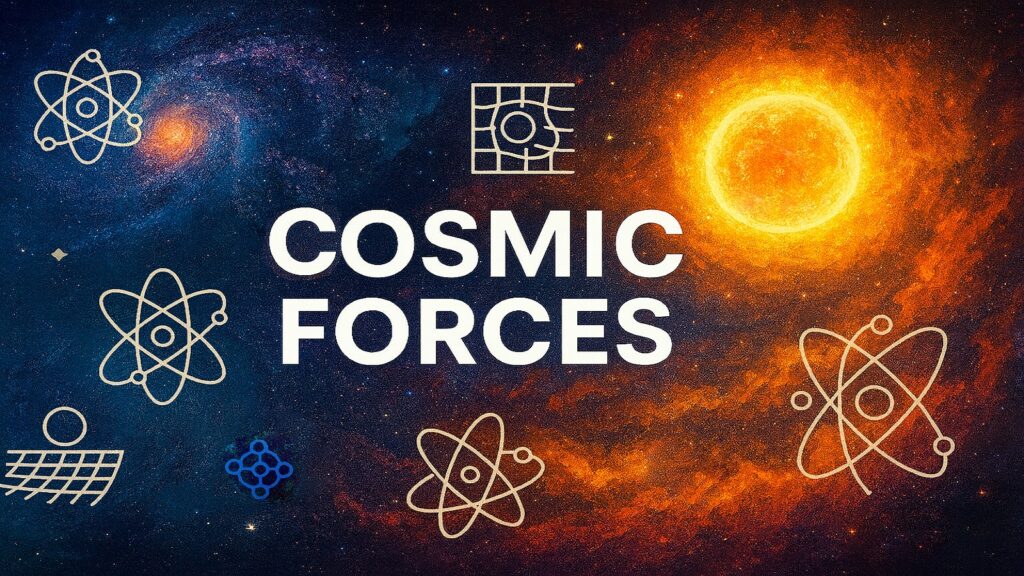Table of Contents
Introduction: Cosmic Forces – 8 Powerful Cosmic Phenomena Shaping Our Universe
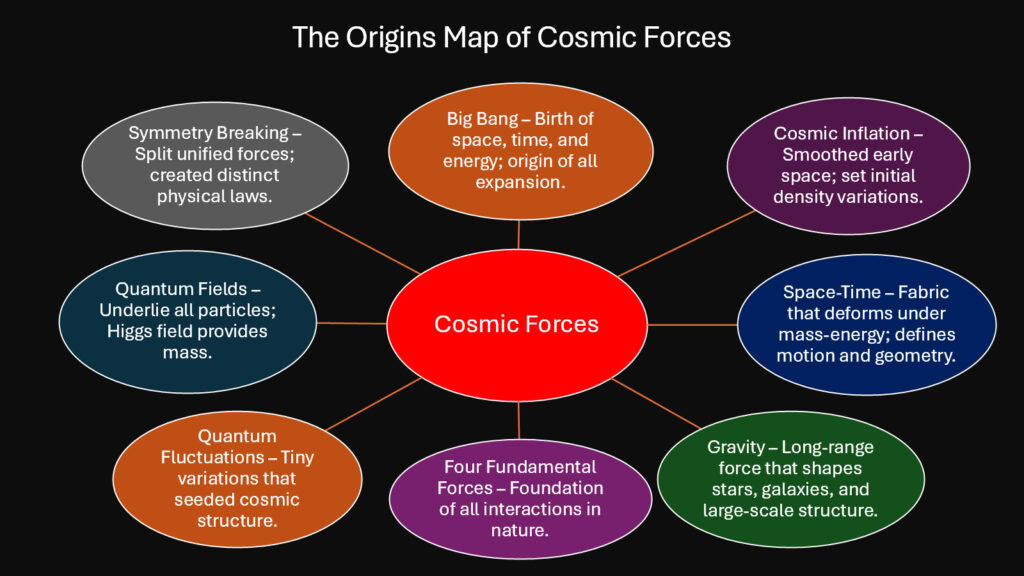
The Universe didn’t simply appear from nothing and drift into its current shape by chance. Instead, a set of specific cosmic forces guided its formation, expansion, and evolution across nearly fourteen billion years. These forces represent the deep physical patterns that control how matter organizes itself, how energy flows through space, and how the laws of nature emerged from an initial burst of creation. Understanding these cosmic forces means grasping why galaxies cluster the way they do, why atoms hold together, and why time itself moves forward.
Each of these eight cosmic forces played a distinct role in shaping the Universe we inhabit. Some operated in the first fractions of a second after creation, while others continue to sculpt cosmic structure today. The Big Bang initiated everything, while cosmic inflation smoothed out early irregularities. Space-time provides the fabric on which all events unfold, and gravity acts as the master architect of large-scale structure. The four fundamental forces govern every interaction between particles, and quantum fluctuations seeded the patterns that became galaxies. Quantum fields give substance to all matter, and symmetry breaking establishes the physical laws that define reality.
These cosmic forces emerged in sequence during the early moments of creation. The Big Bang sparked the initial expansion, followed immediately by cosmic inflation that stretched space exponentially. As the Universe cooled, symmetry breaking separated the fundamental forces and gave particles their distinct identities. Quantum fluctuations rippled through space, creating density variations that gravity later amplified into cosmic structures. Throughout this process, space-time curved and flexed while quantum fields filled every region of existence. Each force is connected to the others in ways that scientists continue to study and decode.
Cosmic Forces: Overview of Eight Fundamental Phenomena
| Cosmic Force | Primary Function |
|---|---|
| Big Bang | Initiated expansion of space, time, and energy from a singularity |
| Cosmic Inflation | Exponentially expanded space and smoothed density variations |
| Space-Time | Provides dynamic fabric that curves and transmits gravitational effects |
| Gravity | Attracts mass across distances and shapes cosmic structure |
| Four Fundamental Forces | Govern all particle interactions and physical processes |
| Quantum Fluctuations | Created initial density variations that seeded galaxy formation |
| Quantum Fields | Generate particles and give mass through field excitations |
| Symmetry Breaking | Separated forces and established distinct particle properties |
1. Cosmic Forces: The Big Bang as the First Great Power

The Big Bang represents the foundational cosmic force from which everything else emerged. Around 13.8 billion years ago, space itself began expanding from an infinitely dense point, carrying energy and matter outward in all directions. This wasn’t an explosion into existing space but rather an expansion of space itself, creating both the arena and the contents of the Universe simultaneously. The Big Bang set the initial conditions for temperature, density, and energy distribution that would shape all subsequent cosmic evolution.
What makes the Big Bang unique among cosmic forces is that it continues to influence the Universe today. Astronomers observe galaxies moving away from each other because space keeps expanding, a direct consequence of that initial burst. The cosmic microwave background radiation fills the sky as a remnant of the intense heat from the first few hundred thousand years. These observations confirm that the Big Bang wasn’t merely a starting event but an ongoing process that defines how the cosmos grows and changes.
The earliest moments after the Big Bang unfolded through several distinct stages, each characterized by different physical conditions. In the first fraction of a second, the Universe existed as an incredibly hot, dense plasma where particles couldn’t form stable structures. As expansion cooled things down, quarks combined into protons and neutrons, which later fused into the first atomic nuclei. Eventually, neutral atoms formed when electrons joined with nuclei, allowing light to travel freely through space for the first time.
Scientists have pieced together the Big Bang timeline through observations of distant galaxies, measurements of cosmic radiation, and particle physics experiments. The theory successfully predicts the abundance of light elements like hydrogen and helium, the temperature of background radiation, and the large-scale structure of galaxy distribution. These pieces of evidence support the view that the Big Bang established the baseline from which all other cosmic forces would operate and interact.
Cosmic Forces: Eight Key Stages of Big Bang Evolution
| Stage | Description |
|---|---|
| Planck Epoch | First 10-43 seconds when quantum effects dominated space-time |
| Grand Unification | Strong force separated from electroweak force around 10^-36 seconds |
| Inflationary Period | Exponential expansion between 10-36 and 10-32 seconds |
| Quark Epoch | Free quarks and gluons existed in plasma from 10-12 to 10-6 seconds |
| Hadron Formation | Quarks combined into protons and neutrons at one microsecond |
| Nucleosynthesis | Light nuclei formed between 10 seconds and 20 minutes |
| Recombination | Atoms formed and Universe became transparent at 380,000 years |
| Structure Formation | Gravity pulled matter into first stars and galaxies after 100 million years |
2. Cosmic Forces: How Cosmic Inflation Reshaped the Early Universe

Cosmic inflation solved several puzzles about why the Universe appears so uniform across vast distances. In the first tiny fraction of a second after the Big Bang, space expanded exponentially faster than light speed, growing by a factor of at least 1026 in less than a trillionth of a trillionth of a second. This rapid stretching smoothed out any irregularities in the initial conditions, explaining why regions of space separated by billions of light-years have nearly identical temperatures and densities today.
The inflationary period among cosmic forces also explains where structure came from in the first place. Quantum fluctuations that existed on subatomic scales got stretched to cosmic proportions during inflation. These tiny variations in energy density became the seeds for galaxy formation, creating a pattern of slightly overdense and underdense regions throughout space. Without inflation, the Universe would either be perfectly smooth with no galaxies or wildly irregular with extreme density contrasts.
Physicist Alan Guth proposed the inflationary theory in 1980 to address the horizon problem and flatness problem in cosmology. The horizon problem questioned how distant regions of space could have the same temperature without ever being in contact. The flatness problem wondered why the Universe’s geometry appears so close to perfectly flat. Inflation resolved both issues by proposing that all observable space originated from a tiny region that had time to reach equilibrium before inflation stretched it to cosmic scales.
Evidence for inflation comes from precise measurements of the cosmic microwave background. The pattern of temperature fluctuations matches predictions from inflationary models, showing a specific spectrum of variations across different angular scales. Recent observations from space missions and ground telescopes continue to test inflationary predictions, refining our understanding of this crucial cosmic force that set up the large-scale structure of everything we observe.
Cosmic Forces: Eight Essential Features of Cosmic Inflation
| Feature | Significance |
|---|---|
| Exponential Expansion | Space grew by factor of 10^26 in less than 10^-32 seconds |
| Flatness Solution | Stretched space to make geometry appear flat at observable scales |
| Horizon Resolution | Allowed distant regions to share common temperature before separation |
| Quantum Stretching | Amplified microscopic fluctuations to cosmic proportions |
| Scalar Field Driver | Hypothetical inflaton field provided energy for rapid expansion |
| Density Variations | Created pattern of overdense and underdense regions for structure formation |
| Reheating Phase | Converted inflaton energy into particles at end of inflation |
| Observable Predictions | Produced specific pattern of temperature fluctuations in cosmic background |
3. Cosmic Forces: The Role of Space-Time in Shaping Reality
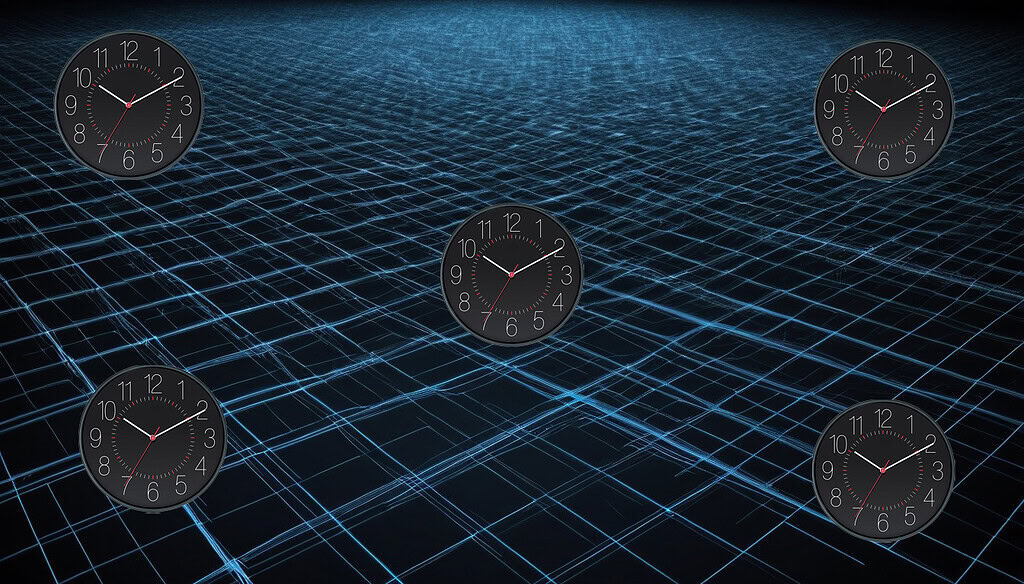
Space-time isn’t simply an empty container where events happen but an active participant among cosmic forces. Albert Einstein revolutionized physics by showing that space and time form a unified fabric that can bend, stretch, and ripple. Mass and energy curve this fabric, creating what we experience as gravity. Objects moving through space-time follow paths determined by its curvature, much like marbles rolling on a stretched rubber sheet follow the contours created by heavier objects.
The dynamic nature of space-time means it responds to the presence of matter and energy while also influencing how they move and interact. Near massive objects like stars or black holes, space-time curves sharply, causing time to pass more slowly and light to bend as it travels past. This warping of space-time explains phenomena like gravitational lensing, where distant galaxies appear distorted by the gravity of intervening galaxy clusters, and time dilation, where clocks run at different rates depending on gravitational strength.
Space-time also carries information through gravitational waves, which are ripples that propagate at light speed when massive objects accelerate. The detection of gravitational waves from colliding black holes and neutron stars confirmed that space-time can oscillate and transmit energy across cosmic distances. These waves provide a new way to observe the Universe, revealing events that produce no light but shake the fabric of space itself.
Understanding space-time as a cosmic force helps explain how the Universe can expand without having a center or edge. Every point in space moves away from every other point as space-time itself grows, rather than galaxies flying through static space. This expansion means that distant galaxies recede faster than nearby ones, with the most remote objects moving away at speeds exceeding light speed relative to us, yet never actually traveling through space faster than light.
Cosmic Forces: Eight Key Properties of Space-Time
| Property | Description |
|---|---|
| Four Dimensions | Combines three spatial dimensions with one time dimension |
| Curvature by Mass | Mass and energy warp geometry according to Einstein field equations |
| Time Dilation | Time passes at different rates depending on gravitational strength |
| Length Contraction | Objects appear compressed along direction of motion at high speeds |
| Light Speed Limit | Information cannot travel faster than 299,792 kilometers per second |
| Gravitational Waves | Ripples in space-time propagate from accelerating massive objects |
| Expansion Capability | Space-time can grow uniformly carrying galaxies apart |
| Frame Dragging | Rotating mass twists nearby space-time in direction of rotation |
4. Cosmic Forces: Gravity as the Universe’s Master Sculptor

Gravity stands out among cosmic forces as the architect of large-scale structure throughout the Universe. While it represents the weakest of the four fundamental forces at atomic scales, gravity dominates across cosmic distances because it always attracts and never repels. Every piece of matter pulls on every other piece, and these tiny tugs accumulate to create powerful effects that shape galaxies, form stars, and direct the motion of planets across billions of years.
The story of cosmic structure formation is essentially the story of gravity amplifying initial density variations. After cosmic inflation seeded small differences in matter distribution, gravity began pulling material toward slightly denser regions. Over millions of years, these overdense areas attracted more matter, growing into the first stars and galaxies. Gravity continues this work today, pulling galaxies into clusters and superclusters while leaving vast voids between them, creating the cosmic web pattern that defines the Universe’s largest structures.
Stars exist because gravity compresses gas clouds until nuclear fusion ignites in their cores. The balance between gravitational collapse and outward pressure from fusion determines a star’s size, temperature, and lifetime. When massive stars exhaust their fuel, gravity crushes their cores into neutron stars or black holes, the most extreme gravitational objects in nature. Black holes warp space-time so severely that not even light escapes their pull, making them cosmic laboratories for testing gravity under extreme conditions.
Gravity also influences the Universe’s ultimate fate. For decades, scientists debated whether gravitational attraction would eventually halt cosmic expansion and pull everything back together in a Big Crunch. Observations of distant supernovae revealed instead that expansion is accelerating, driven by dark energy that counteracts gravity across the largest scales. Yet gravity remains the dominant cosmic force shaping structure within galaxy clusters and smaller regions, where its attractive power still outweighs dark energy’s repulsive effect.
Cosmic Forces: Eight Major Roles of Gravity in Cosmic Evolution
| Gravitational Role | Impact on Universe |
|---|---|
| Structure Amplification | Grew density variations into galaxies and galaxy clusters |
| Star Formation | Compressed gas clouds until fusion ignited in stellar cores |
| Orbit Maintenance | Keeps planets circling stars and stars orbiting galactic centers |
| Black Hole Creation | Crushes massive stellar cores into black hole singularity |
| Gravitational Lensing | Bends light from distant objects revealing dark matter distribution |
| Cosmic Web Formation | Organized matter into filaments and sheets separated by voids |
| Galaxy Mergers | Pulls nearby galaxies together creating larger elliptical systems |
| Expansion Opposition | Works against cosmic expansion at scales below galaxy clusters |
5. Cosmic Forces: The Four Fundamental Forces Governing Nature

Four fundamental forces control every interaction in the Universe, making them the most basic cosmic forces from which all physical processes emerge. These forces are gravity, electromagnetism, the strong nuclear force, and the weak nuclear force. Each operates at different distance scales and governs different aspects of how matter and energy behave. Together, they determine everything from how atomic nuclei hold together to how light travels through space.
Gravity, already discussed as a cosmic force, reaches across infinite distances, though its strength diminishes with separation. Electromagnetism also acts over long ranges, binding electrons to atomic nuclei and generating light waves that carry information across the cosmos. The electromagnetic force explains chemistry, since atomic bonding relies on electromagnetic attraction between positive nuclei and negative electrons. Light itself consists of electromagnetic waves, making this force responsible for nearly everything we see.
The strong nuclear force binds quarks together inside protons and neutrons, and holds these particles together in atomic nuclei despite electromagnetic repulsion between positively charged protons. This force operates only at distances comparable to atomic nuclei’ sizes, about one femtometer or 10-15 meters. Despite its limited range, the strong force provides the binding energy that powers stars through fusion and stores the energy released in nuclear reactions.
The weak nuclear force governs radioactive decay and plays a crucial role in how stars shine. During fusion in stellar cores, the weak force converts protons into neutrons through beta decay, enabling the reactions that generate starlight. This force also separated from electromagnetism during symmetry breaking in the early Universe, establishing distinct identities for particles and setting up the physical laws that would govern matter from that point forward.
Cosmic Forces: Eight Characteristics of the Four Fundamental Forces
| Characteristic | Details |
|---|---|
| Gravity Range | Infinite reach but weakest force at particle scales |
| Electromagnetic Range | Infinite reach governing atomic structure and light |
| Strong Force Range | Limited to nuclear distances around 10^-15 meters |
| Weak Force Range | Shortest range around 10^-18 meters governing decay |
| Relative Strengths | Strong: 1, Electromagnetic: 10^-2, Weak: 10^-13, Gravity: 10^-39 |
| Force Carriers | Graviton (theoretical), photon, gluons, W and Z bosons |
| Unification History | All forces unified at Planck energy then separated through cooling |
| Current Understanding | Three forces unified in Standard Model, gravity described by General Relativity |
6. Cosmic Forces: Quantum Fluctuations That Seeded All Structure

Quantum fluctuations represent the smallest cosmic forces yet triggered the largest structures in existence. At quantum scales, the Heisenberg uncertainty principle prevents both position and momentum from being precisely defined simultaneously, causing constant fluctuations in energy even in seemingly empty space. These tiny variations in the quantum vacuum existed throughout the early Universe, appearing and disappearing on subatomic scales with no lasting impact under normal conditions.
Everything changed when cosmic inflation stretched these quantum fluctuations to astronomical sizes. Fluctuations that started smaller than atomic nuclei got blown up to galactic and even super-galactic scales during the exponential expansion phase. Once stretched beyond the quantum realm, these fluctuations became classical density variations frozen into the fabric of space. Some regions ended up slightly denser than average, others slightly less dense, creating the pattern that gravity would later amplify into galaxies and cosmic structure.
The connection between quantum fluctuations and galaxy formation represents one of the most remarkable aspects of cosmic evolution. Observations of the cosmic microwave background show temperature variations of about one part in 100,000 across different directions of the sky. These tiny differences correspond exactly to the density variations predicted from stretched quantum fluctuations. Regions that started slightly denser appear slightly hotter in the microwave background, and these same regions eventually became the locations where galaxies formed.
Without quantum fluctuations among cosmic forces, the Universe would be perfectly uniform with no structures at all. Every region of space would contain exactly the same density of matter and energy, leaving nothing for gravity to work with in building galaxies. The quantum nature of reality in the earliest moments created just enough irregularity to seed structure formation while maintaining the overall smoothness that inflation established. This delicate balance between uniformity and variation made our existence possible.
Cosmic Forces: Eight Aspects of Quantum Fluctuations in Cosmic Structure
| Aspect | Explanation |
|---|---|
| Uncertainty Origin | Heisenberg principle causes unavoidable energy variations in quantum vacuum |
| Scale Transformation | Inflation stretched subatomic fluctuations to galactic scales |
| Density Variations | Created pattern of overdense and underdense regions throughout space |
| Statistical Distribution | Fluctuations followed Gaussian distribution with nearly scale-invariant spectrum |
| CMB Imprint | Temperature variations in microwave background reveal fluctuation pattern |
| Gravitational Seeds | Density differences provided starting points for gravitational collapse |
| Structure Formation | Evolved into cosmic web of galaxies, clusters, and voids |
| Observational Match | Large-scale structure distribution matches predictions from quantum origins |
7. Cosmic Forces: Quantum Fields That Give Shape and Mass to Reality

Quantum fields form the fundamental layer of reality according to modern physics. Rather than thinking of particles as tiny solid objects, quantum field theory describes everything as excitations or vibrations in underlying fields that fill all of space. An electron isn’t a particle traveling through the electron field but rather represents a localized excitation of that field. Photons exist as ripples in the electromagnetic field, and quarks emerge from excitations in quark fields. These cosmic forces operating at quantum scales give rise to all matter and energy in the Universe.
Every type of particle corresponds to its own quantum field. The Universe contains fields for electrons, quarks, photons, neutrinos, and all other fundamental particles. These fields exist everywhere simultaneously, pervading every point in space, whether or not any particles happen to be present in that location. When enough energy concentrates in a particular region, it can excite a field and create a particle. Conversely, when particles annihilate, their energy returns to the underlying field from which they came.
The Higgs field stands out among quantum fields for its role in giving mass to particles. Most fundamental particles acquire their mass through interactions with the Higgs field, which fills all of space with a nonzero value even in its lowest energy state. Particles that interact strongly with the Higgs field experience more resistance moving through space, manifesting as greater mass. The discovery of the Higgs boson at CERN in 2012 confirmed this mechanism and validated decades of theoretical predictions about how mass originates.
Quantum fields unify the concepts of particles and forces within a single framework. Force carrier particles like photons and gluons emerge from field excitations just like matter particles. This means electromagnetic and nuclear forces arise from exchanges of field excitations between matter particles. The Standard Model of particle physics describes all known particles and their interactions through quantum field theory, making these fields the most fundamental cosmic forces that govern the behavior of everything in nature.
Cosmic Forces: Eight Key Features of Quantum Fields
| Feature | Description |
|---|---|
| Universal Presence | Fields fill all of space continuously at every point |
| Particle Creation | Localized excitations in fields manifest as observable particles |
| Higgs Mechanism | Higgs field interactions generate mass for fundamental particles |
| Force Mediation | Forces arise from exchange of field excitations between particles |
| Vacuum Energy | Fields maintain nonzero energy even in ground state |
| Quantum Superposition | Fields exist in multiple states simultaneously until measured |
| Field Quantization | Energy exists in discrete packets rather than continuous values |
| Standard Model Framework | Twelve matter fields and four force fields describe all known physics |
8. Cosmic Forces: Symmetry Breaking and the Birth of Physical Laws
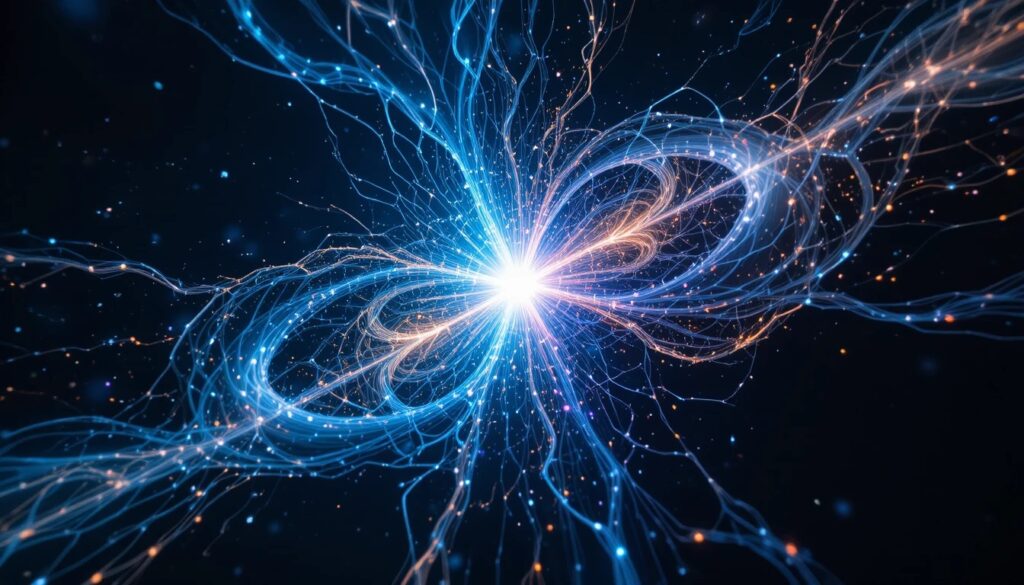
Symmetry breaking ranks among the most important cosmic forces because it established the distinct physical laws and particle properties that define our Universe. In the earliest moments after the Big Bang, the Universe existed in a state of perfect symmetry where all fundamental forces behaved identically and particles had no distinct identities. As the Universe expanded and cooled, this symmetry spontaneously broke in a series of phase transitions, similar to how water suddenly freezes into ice when the temperature drops below a critical point.
The first major symmetry breaking occurred when gravity separated from the other forces during the Planck epoch. As the Universe continued cooling, the strong nuclear force split off from the electroweak force in the grand unification transition around 10-36 seconds after the Big Bang. Later still, at about 10-12 seconds, the electromagnetic and weak forces separated into distinct entities with different properties and interaction ranges. Each breaking reduced symmetry but gave the forces their unique characteristics.
Symmetry breaking also determined which particles exist and what properties they possess. Before electroweak symmetry breaking, particles had no mass, and photons were indistinguishable from W and Z bosons. The Higgs field acquired a nonzero vacuum value during this transition, giving mass to some particles while leaving others, like photons massless. This same process established why electrons differ from neutrinos and why quarks come in six different types with distinct masses and charges.
The pattern of symmetry breaking explains one of the deepest mysteries in cosmology: why the Universe contains matter instead of equal amounts of matter and antimatter. During the electroweak phase transition, subtle differences in how particles and antiparticles interact created a slight excess of matter. This tiny imbalance, about one extra matter particle for every billion matter-antimatter pairs, meant some matter survived after most particles annihilated with their antimatter counterparts. Understanding symmetry breaking among cosmic forces reveals why the Universe developed the specific set of physical laws that allow complexity and life to emerge.
Cosmic Forces: Eight Critical Symmetry Breaking Events
| Breaking Event | Consequence |
|---|---|
| Planck Scale Breaking | Gravity separated from other forces at 10-43 seconds |
| Grand Unification Breaking | Strong force split from electroweak at 10-36 seconds |
| Electroweak Breaking | Electromagnetic and weak forces separated at 10-12 seconds |
| Higgs Field Activation | Particles acquired mass through field interaction |
| CP Violation | Created matter-antimatter asymmetry allowing matter to dominate |
| Quark Confinement | Quarks bound into protons and neutrons at one microsecond |
Conclusion: Cosmic Forces – 8 Powerful Cosmic Phenomena That Built Our Universe
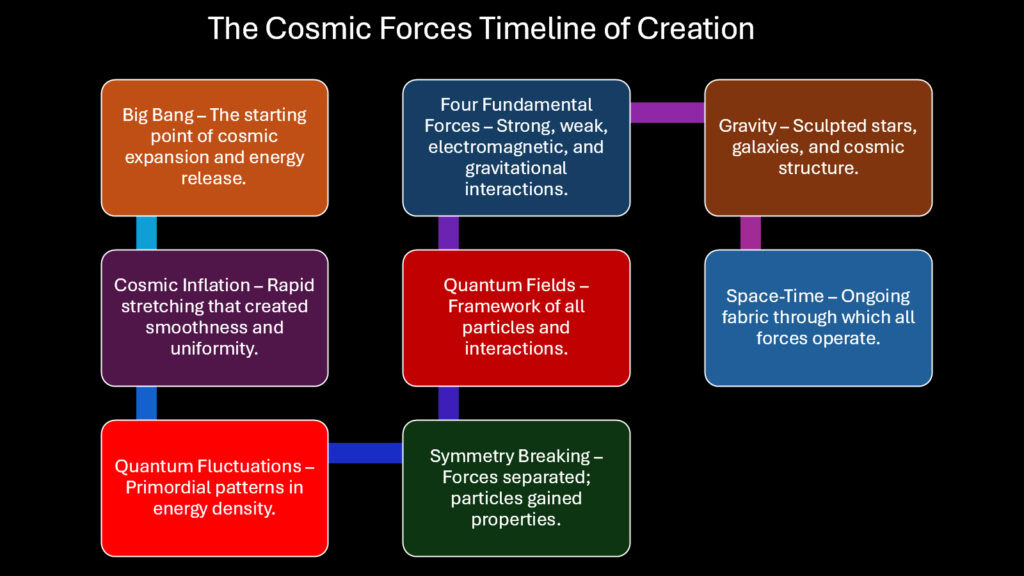
These eight cosmic forces weave together into a single narrative that spans from the first instant of creation to the complex structures we observe today. The Big Bang initiated everything, setting space and time into motion and establishing the initial conditions from which all else would follow. Cosmic inflation immediately amplified this beginning, stretching space exponentially and smoothing out irregularities while preserving quantum fluctuations that would become crucial later. Space-time emerged as the dynamic stage on which these cosmic forces would interact, curving and flexing in response to energy and matter.
As the Universe cooled, symmetry breaking separated the fundamental forces and gave particles their distinct identities, establishing the physical laws that would govern reality from that moment forward. Quantum fields filled every point in space, with their excitations manifesting as the particles that make up everything we see. Tiny quantum fluctuations, stretched to cosmic proportions by inflation, created the density variations that gravity would amplify over billions of years. Gravity itself became the master sculptor, pulling matter together into stars, galaxies, and the vast cosmic web that defines the large-scale structure of existence.
Each cosmic force contributed something essential to the larger story. Without the Big Bang, there would be no Universe at all. Without inflation, the cosmos would lack the uniformity and structure needed for galaxies to form. Without space-time, matter and energy would have no arena in which to exist and interact. Without gravity, structure would never coalesce from the initial smooth distribution of matter. Without the four fundamental forces, particles couldn’t interact in the ways that enable chemistry, nuclear fusion, and the processes that power stars.
Quantum fluctuations provided the seeds, while quantum fields supplied the substance from which everything emerged. Symmetry breaking established the rules, determining which particles exist and how they behave. These cosmic forces didn’t operate in isolation but worked together in intricate ways. Inflation stretched quantum fluctuations, gravity amplified them, space-time curved around the resulting structures, and the fundamental forces governed how matter organized itself within those structures.
Understanding these cosmic forces deepens our sense of the Universe in profound ways. We recognize that galaxies didn’t simply appear randomly scattered through space but formed from specific physical processes operating over billions of years. We grasp that the laws of physics emerged from symmetry breaking rather than existing as eternal unchanging rules. We appreciate that quantum mechanics and gravity, often seen as separate domains, both played crucial roles in shaping cosmic structure from the smallest to the largest scales.
Cosmic Forces: Six Key Connections Between Early Universe and Present Day
| Connection | How Cosmic Forces Link Past to Present |
|---|---|
| Expansion Continuity | Big Bang expansion continues today as galaxies move apart |
| Structural Legacy | Inflation and quantum fluctuations created patterns visible in galaxy distribution |
| Physical Law Stability | Symmetry breaking fixed force strengths and particle properties permanently |
| Gravitational Shaping | Gravity transformed initial density variations into stars and galaxies over billions of years |
| Field Permanence | Quantum fields established in first moments still pervade all space |
| Unified Framework | Symmetry-breaking fixed force strengths and particle properties permanently |

